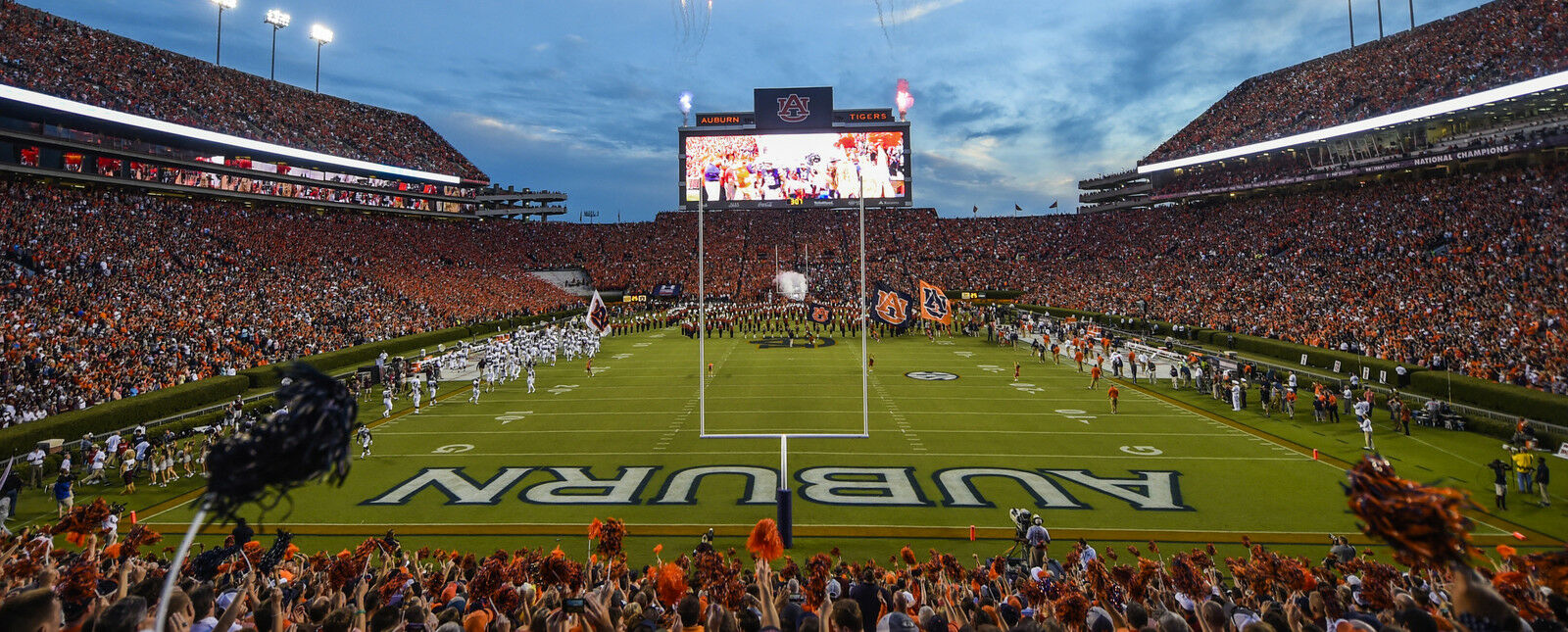Jordan-Hare Stadium Information

Pat Dye Field at Jordan-Hare Stadium, the nation’s 10th-largest on-campus stadium in the nation. The stadium has a capacity of 87,451 and has served as the home of the Auburn Tigers since 1939. While serves mainly as a football stadium, it has hosted a handful of other events. Some of these events include an appearance by Billy Graham; concert appearances by James Brown, The Beach Boys, Miranda Lambert, Kenny Chesney, and Blake Shelton.
The stadium is named after Ralph “Shug” Jordan. Coach Jordan was Auburn’s all-time highest wins football coach. Where else, Clifford Leroy Hare was a member of Auburn’s first football team and president of the old Southern Conference. He was also the longtime chairman of Auburn’s Faculty Athletic Committee.
On the other hand, Pat Dye Field was named in honor of former Auburn coach and athletic director, Pay Dye, on 19th November 2005. Dye served as head coach and athletics director at Auburn from 1981-1992. He was also inducted into the College Football Hall of Fame in December 2005. Additionally, he led Auburn into a 99-39-4 record and four SEC Championships in his 12 seasons on the Plains.
Prior to Thanksgiving Day (November 30, 1939), Auburn played its home games at a bare-bones facility seating only 700 people in temporary bleachers. It was then that the university decided to build the permanent Auburn Stadium. Despite that the stadium was opened in 1939, most games were not played at the Auburn Stadium. Auburn played home games against their competitors at neutral sites due to the difficulty in traveling to Auburn and the initial 15,000-seat capacity. Auburn only played 12 true home games till the 1970s.
The first varsity game played in the stadium, a 7–7 tie with the University of Florida under Auburn head coach Jack Meagher. Although the Auburn-Florida game was originally scheduled for December 2, 1939, in Montgomery. The game was rescheduled in order for the stadium to be dedicated on Thanksgiving Day of the opening year. The Auburn officials wanted the significance of the occasion to link with America’s established Thanksgiving Day football tradition. The official attendance of 7,290 for the dedication game based on the number of tickets printed for the game. However, a thanks-for-coming note from Jack Meagher calculated the actual attendance as 11,095. Additionally, newspaper accounts reported that anywhere from 12,000-14,000 people were in attendance so no one is actually sure about the number of attendees for the dedication game at Auburn Stadium.
The stadium reached its current seating capacity of 87,451 with the 2004 expansion. It was estimated that 19,308,753 total spectators had attended a football game in Jordan–Hare by the end of the 2006 season. Furthermore, Jordan–Hare Stadium regularly makes lists of the best gameday atmospheres and it claimed by footballers that it is one of the most intimidating places to play.
In 2015, Auburn considered a complete reconstruction of the north end zone section of the stadium. The reconstruction was to include new premium club seating and lounges, and a new home locker room to replace the existing facility in the south end-zone. The total cost of this renovation was estimated at $145 million.However, after surveying donors and the general fanbase, the university did not move forward with those plans.
Instead, the university decided to build a $28 million gameday support facility in the southwest corner of the stadium. Renovation and expansion of the existing home locker room, relocation of the press box, a new player recruiting lounge, and a new premium fan club providing overviews of the end of Tiger Walk are in the plan. In addition, the existing 12,000 square-foot press box in the west upper deck is being converted to an additional premium club seating and lounge area. The coaches boxes and television box will in the same area as the premium club seating area and will be renovated. The total cost for this project is at $12 million and it is expected to be completed by the 2018 season.
|
Capacity |
Years |
| 15,000 | 1939–1948 |
| 21,500 | 1949–1954 |
| 34,500 | 1955–1959 |
| 44,500 | 1960–1969 |
| 61,261 | 1970–1979 |
| 72,169 | 1980–1986 |
| 85,214 | 1987–1999 |
| 85,612 | 2000 |
| 86,063 | 2001–2003 |
| 87,451 | 2004–present |
For further information on the Jordan-Hare Stadium at Auburn University, visit the pages listed below.
Parking Information:
Read about parking options available to event goers on the Jordan-Hare Stadium parking information page.
Ticket Policies:
For information on ticket guarantee and on our preferred ticket marketplace please view the Jordan-Hare Stadium tickets page.
Seating Chart & Information:
For information on accessible seating and see the venues seating map, please view the Jordan-Hare Stadium seating chart page.